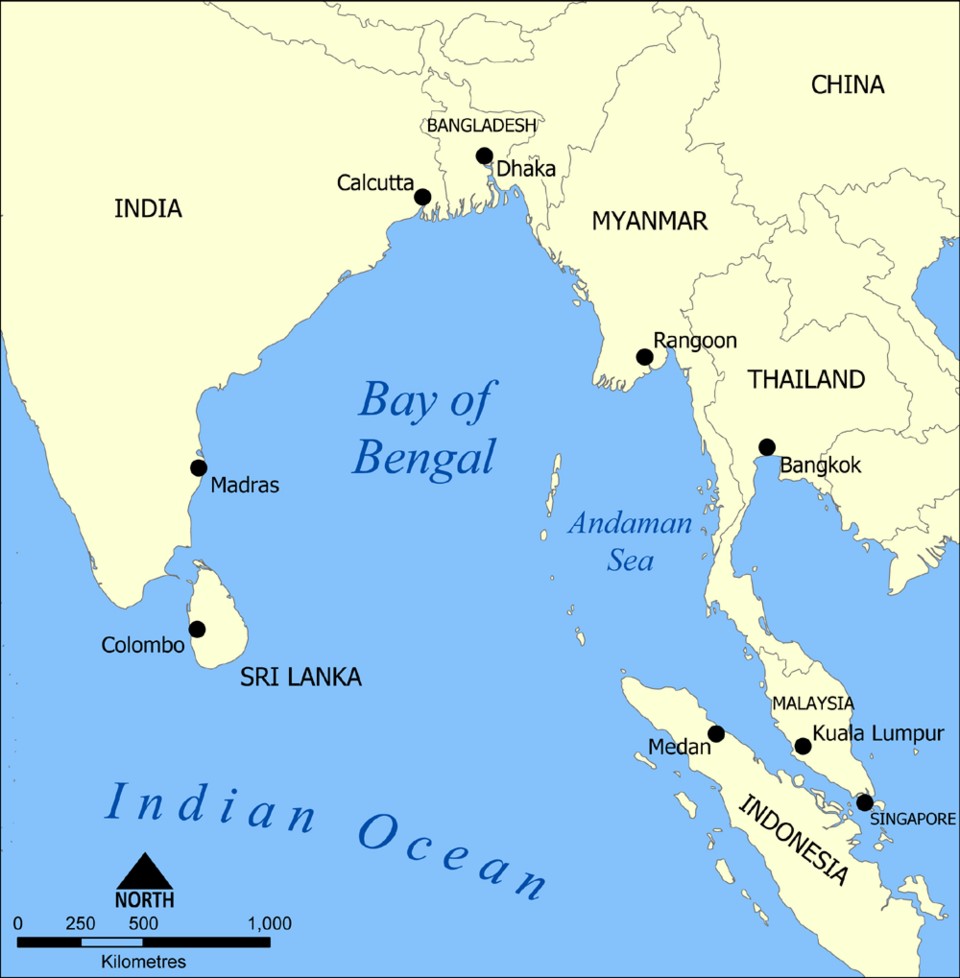INDIA’S STRATEGIC DILEMMA IN BAY REGION
Syllabus:
GS-2: Look East to Act East, Regional Groupings, Effect of Policies & Politics of Countries on India’s Interests
WHY IN THE NEWS?
India recently revoked the transshipment facility for Bangladesh, impacting its garment export logistics. This move came soon after Dhaka’s diplomatic engagement with China and a controversial speech by Bangladesh’s interim Chief Adviser in Beijing. The timing, followed by import restrictions, has raised concerns about India’s approach to regional diplomacy and cooperative regionalism in the Bay of Bengal, particularly within the context of BIMSTEC (Bay of Bengal Initiative for Multi-Sectoral Technical and Economic Cooperation). This development is significant for BIMSTEC UPSC aspirants, as it highlights the complex interplay of regional politics and economic cooperation in South Asia, emphasizing the importance of regional trade diplomacy.

TRADE TRENDS
● Maritime Growth: India’s eastern ports — Visakhapatnam, Paradip, and Haldia — have seen rising cargo throughput, reflecting increased trade integration and Bay of Bengal connectivity.
● BIMSTEC Agreement: The BIMSTEC Maritime Agreement, signed earlier this year, aims to harmonise customs and reduce port costs. This agreement is a key step towards enhancing BIMSTEC connectivity and facilitating cross-border trade in the region, promoting Bay of Bengal integration and maritime transport cooperation.
● Policy Push: Initiatives under the Sagarmala programme and GST incentives have promoted coastal shipping and improved maritime logistics. These efforts align with India’s Act East Policy, fostering regional economic integration and strengthening regional value chains among BIMSTEC countries.
● Trade Optimism: For the first time in years, trade integration in the Bay of Bengal shows positive momentum, indicating progress in BIMSTEC priority sectors and potentially paving the way for a BIMSTEC Free Trade Agreement.
● Regional Port Reliance: Smaller economies such as Nepal, Bhutan, and Myanmar heavily rely on Indian port access, enhancing India’s regional leverage and promoting intra-regional trade. This has led to discussions about concessional port dues to further boost regional trade within the BIMSTEC framework.
| Understanding BIMSTEC Grouping: A Regional Cooperation Framework |
| About BIMSTEC: |
| ● Full Form: Bay of Bengal Initiative for Multi-Sectoral Technical and Economic Cooperation (BIMSTEC full form) |
| ● Members: 7 BIMSTEC countries – Bangladesh, Bhutan, India, Myanmar, Nepal, Sri Lanka, and Thailand. |
| ● Region Covered: Encompasses the Bay of Bengal region, connecting South Asia and Southeast Asia. |
| ● Population & Economy: Represents 1.5 billion people and a combined GDP of over USD 3.8 trillion. |
| ● Objective: Promote technical, economic, and multi-sectoral cooperation among member states. |
| Origin and Evolution: |
| ● Established: BIMSTEC was established in 1997 through the Bangkok Declaration. According to BIMSTEC Wikipedia, the organization was initially known as BIST-EC. |
| ● Initial Name: BIST-EC (Bangladesh, India, Sri Lanka, and Thailand Economic Cooperation). |
| ● Name Change 1: Became BIMST-EC after Myanmar joined in 1997. |
| ● Name Change 2: Renamed BIMSTEC in 2004 after Nepal and Bhutan joined. |
| ● Current Focus: Cooperation in 14 priority sectors including trade, technology, energy, transport, tourism, and fisheries. |
| ● Strategic Importance: Serves as a bridge between South and Southeast Asia, promoting regional integration and security. |
| ● BIMSTEC Secretariat: Located in Dhaka, Bangladesh, serving as the BIMSTEC headquarters. |
| ● BIMSTEC Secretary General: Appointed to oversee the organization’s activities. |
| ● BIMSTEC Chairman: Rotates among member countries, providing leadership to the group. |
DIPLOMATIC DISCORD
● Facility Withdrawal: India’s termination of the Bangladesh transshipment facility was officially for logistical reasons, but seen as political signalling within the BIMSTEC context.
● Strategic Remarks: Bangladesh’s claim that India’s Northeast is landlocked and Dhaka is its maritime gateway triggered discontent in New Delhi, highlighting the need for improved regional trade diplomacy.
● Geopolitical Undertone: The move came after increased Bangladesh-China engagement, hinting at India’s strategic unease and potentially impacting BIMSTEC cooperation.
● Connectivity Contest: India is keen to present itself as the regional integrator, especially via infrastructure and trade, emphasizing its role in BIMSTEC connectivity initiatives.
● Image Risk: Moves perceived as retaliatory undermine India’s credibility as a neutral trade facilitator in South Asian trade, potentially affecting BIMSTEC cooperation and the implementation of agreements like the BIMSTEC Maritime Agreement.
BANGLADESH BACKLASH
● Export Setback: Bangladeshi exporters, especially in ready-made garments (RMG), now face higher costs and longer transit times due to changes in transshipment of cargo arrangements, impacting Bangladesh’s participation in BIMSTEC trade initiatives.
● Sector Impact: RMG contributes over 85% to Bangladesh’s foreign earnings; dependence on Indian ports was strategic for enhancing কানেক্টিভিটি (connectivity) within the BIMSTEC region.
● Limited Alternatives: Routing through Sri Lanka or Southeast Asian markets is costlier and less efficient for Dhaka, highlighting the importance of BIMSTEC maritime transport cooperation.
● Unilateral Restrictions: India’s further ban on certain Bangladeshi goods via land ports intensified tensions, potentially affecting progress towards a BIMSTEC Free Trade Agreement.
● Disproportionate Response: Bangladesh views India’s trade actions as excessive, especially since transshipment withdrawal preceded yarn restrictions by Dhaka, straining BIMSTEC member relations.
STRATEGIC CONCERNS
● Regional Optics: Moves against Dhaka could alarm other Bay littoral states like Myanmar, Thailand, and Sri Lanka, all BIMSTEC member countries.
● Perceived Coercion: Using trade access as leverage transforms shared infrastructure into geopolitical tools, potentially undermining BIMSTEC’s cooperative spirit.
● Neutrality Erosion: Economic arrangements that once symbolized cooperation are now seen as transactional, challenging BIMSTEC’s foundational principles.
● Credibility Question: For India, retaining trust is as vital as showcasing capacity in port infrastructure development and port efficiency within the BIMSTEC framework.
● Hedging Risk: If neighbours feel India’s policies shift with political winds, they may turn to China or alternate alignments for regional connectivity projects, potentially weakening BIMSTEC’s effectiveness.
CAPACITY VS CREDIBILITY
● Infrastructure Strength: India’s port infrastructure is the most robust in the Bay — efficient, expanding, and strategically located, supporting BIMSTEC connectivity goals.
● Connectivity Lead: With superior multimodal linkages, India remains the top logistical hub in the region for maritime logistics, crucial for implementing the BIMSTEC Maritime Agreement.
● Capacity Is Not Enough: In a fragmented region, credibility often outweighs capacity in securing long-term partnerships, especially within the BIMSTEC framework.
● Leadership Question: True leadership demands stable, rule-based trade access, not transactional adjustments, aligning with BIMSTEC’s objectives for regional cooperation.
● Neighbourhood First?: India’s Neighbourhood First policy risks losing traction if it appears coercive rather than cooperative, potentially impacting its role in BIMSTEC.
THE WAY FORWARD
● Clarify Conditions: India should define the circumstances under which the transshipment arrangement can be restored, considering BIMSTEC’s regional trade facilitation goals.
● Insulate Trade: A rules-based framework should be adopted to protect economic ties from political fallout, potentially through enhanced BIMSTEC mechanisms.
● Strengthen BIMSTEC: India must revitalise BIMSTEC through trust-building and shared infrastructure governance, possibly through initiatives discussed at the BIMSTEC summit 2018.
● Reassure Neighbours: Transparent mechanisms and regional consultations can rebuild confidence in India’s intentions, reinforcing BIMSTEC’s role in regional cooperation.
● Balance Interests: India must assert strategic interests while ensuring it does not alienate Bay littoral states through short-term political signalling, maintaining BIMSTEC’s cohesion.
CONCLUSION
India stands at a crucial crossroads in the Bay of Bengal. As it pursues leadership in regional trade facilitation, it must choose between strategic assertiveness and cooperative engagement within the BIMSTEC framework. A rules-based, stable, and inclusive approach can restore confidence, reinforce regional integration, and affirm India’s commitment to a shared maritime future. The upcoming BIMSTEC summit 2024 presents an opportunity for India to reaffirm its commitment to regional economic growth and maritime cooperation, potentially through initiatives like the BIMSTEC Maritime Agreement and the BIMSTEC Master Plan for Transport Connectivity. By focusing on these collaborative efforts, India can strengthen its position as a key player in South Asian trade and maritime infrastructure investment, while also addressing concerns about environmental sustainability and maritime safety in the region. The success of BIMSTEC and its initiatives could serve as a model for broader regional cooperation, potentially influencing dynamics within SAARC countries as well, despite the SAARC headquarters being located in Kathmandu, Nepal.
Source: TH
MAINS PRACTICE QUESTION
Q. India’s response to Bangladesh’s strategic engagements has exposed the tension between geopolitical interests and economic regionalism in the Bay of Bengal. Critically analyse India’s balancing act in this context and suggest steps for strengthening regional trust through trade diplomacy, particularly within the BIMSTEC framework.







